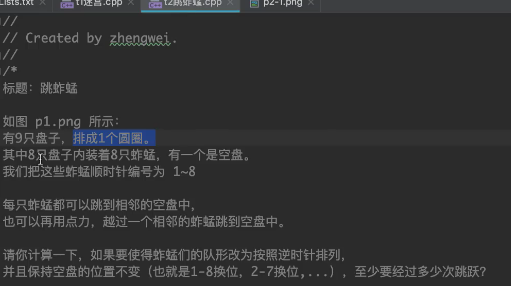

为什么第二题就这么难呜呜呜,这不是为难我吗!!!
可以明确的是,又是一个bfs
最少路径,找满足条件的那个层数
1 #include<iostream> 2 #include<stdio.h> 3 #include<stdlib.h> 4 #include<time.h> 5 #include <strings.h> 6 #include <queue> 7 #include <set> 8 #include <cstring> 9 10 using namespace std; 11 char *start="0123456789"; 12 char *target="0987654321"; 13 14 15 struct StateAndLevel{ 16 char *state; 17 int level; 18 int pos0;//记录0的位置 19 StateAndLevel(char *_state,int _level,int _pos0):state(_state),level(_level),pos0(_pos0){};//构造函数 20 }; 21 22 void swap(char *s,int a,int b) { 23 char t=s[a]; 24 s[a]=s[b]; 25 s[b]=t; 26 } 27 struct cmp{ 28 bool operator ()(char *a,char *b){ 29 return strcmp(a,b)<0; 30 31 } 32 }; 33 queue<StateAndLevel> q; 34 35 set<char *,cmp> allState;//set需要重载一下()运算符:set是用来去重的,但是你得定义啥是重复啊 36 37 void addN(char *state,int pos,int newpos,int le){ 38 39 //添加其他队列成员 40 char *new_state1 = (char *) malloc(9 * sizeof(char)); 41 strcpy(new_state1, state);//把原字符串拷贝过来,然后进行改变 42 //首先寻找一下合适的位置 43 44 //移动字符以形成新的字符串 45 swap(new_state1, pos, newpos); 46 //将改变后的字符插入到set和queue里,注意需要判断是否重复 47 if (allState.find(new_state1) == allState.end()) { 48 allState.insert(new_state1); 49 q.push(StateAndLevel(new_state1, le + 1, newpos));//注意你现在操作的是sal的成员 50 } 51 } 52 53 int main() { 54 q.push(StateAndLevel(start, 0, 0));//先把初始的放进去 55 while (!q.empty())//套路!!! 56 { 57 StateAndLevel sal = q.front(); 58 59 char *state = sal.state; 60 int le = sal.level; 61 cout<<le<<" "<<endl; 62 if (strcmp(state, target) == 0) { 63 cout << le; 64 return 0; 65 } 66 int pos = sal.pos0;//取出所有的当前值,添加到set中去 67 allState.insert(state); 68 69 int newpos = (pos + 1 + 9) % 9; 70 addN(state, pos, newpos, le); 71 72 int newpos2 = (pos - 1 + 9) % 9; 73 addN(state, pos, newpos2, le); 74 75 int newpos3 = (pos - 2 + 9) % 9; 76 addN(state, pos, newpos3, le); 77 78 int newpos4 = (pos + 2 + 9) % 9; 79 addN(state, pos, newpos4, le); 80 q.pop(); 81 82 } 83 84 }
那个add函数,
就是生成一个新的位置,
更改出那个新的字符
然后level+1
其实用bfs搞最小挺常见的emmmmmm